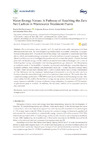Please use this identifier to cite or link to this item:
https://accedacris.ulpgc.es/jspui/handle/10553/75823
| Title: | Water-energy nexus: A pathway of reaching the zero net carbon in wastewater treatment plants | Authors: | Del Río Gamero, Beatriz Ramos Martín, Alejandro Melián Martel, Noemí Pérez Báez, Sebastián Ovidio |
UNESCO Clasification: | 330810 Tecnología de aguas residuales 330806 Regeneración del agua 332205 Fuentes no convencionales de energía |
Keywords: | Case Study Greenhouse Gas Emission Renewable Energies Storage System Wastewater Treatment Plants |
Issue Date: | 2020 | Project: | Mitigación del cambio climático a través de la innovación en el ciclo del agua mediante tecnologías bajas en carbono | Journal: | Sustainability (Switzerland) | Abstract: | The water-energy nexus, together with the need for sustainable management of these interconnected resources, has attracted growing attention from the scientific community. This paper focuses on this nexus from the point of view of the energy that is required by wastewater treatment plants, which are intensive energy consumers and major emitters of greenhouse gases. The main objective of the study is to investigate the possible use of a wastewater plant’s internal chemical, potential, and kinetic energy, and the addition of external renewable technologies with a view to achieving clean energy consumption and reducing greenhouse gas emissions. For this purpose, an analysis is made of the feasibility of introducing alternative technologies—anaerobic digestion, hydraulic turbines, wind turbines, and photovoltaic modules— to meet the plant’s energy needs. The plant chosen as case study (Jinamar plant, Canary Islands, Spain) has an energy consumption of 2956 MWh/year, but the employed methodological framework is suitable for other plants in locations where the renewable energy potential has previously been analyzed. The results show that a renewable energy production of 3396 MWh/year can be obtained, more than enough to meet plant consumption, but also confirm the need for an energy storage system, due to seasonal variability in energy resource availability. In terms of climate change mitigation, the emission of 2754 tons/year of greenhouse gases is avoided. In addition, the economic viability of the proposed system is also confirmed. | URI: | https://accedacris.ulpgc.es/handle/10553/75823 | ISSN: | 2071-1050 | DOI: | 10.3390/su12229377 | Source: | Sustainability (Switzerland) [EISSN 2071-1050],v. 12 (22), p. 1-19, (Noviembre 2020) |
| Appears in Collections: | Artículos |
SCOPUSTM
Citations
17
checked on Jun 8, 2025
WEB OF SCIENCETM
Citations
16
checked on Jun 8, 2025
Page view(s)
133
checked on Sep 7, 2024
Download(s)
35
checked on Sep 7, 2024
Google ScholarTM
Check
Altmetric
Share
Export metadata
Items in accedaCRIS are protected by copyright, with all rights reserved, unless otherwise indicated.
